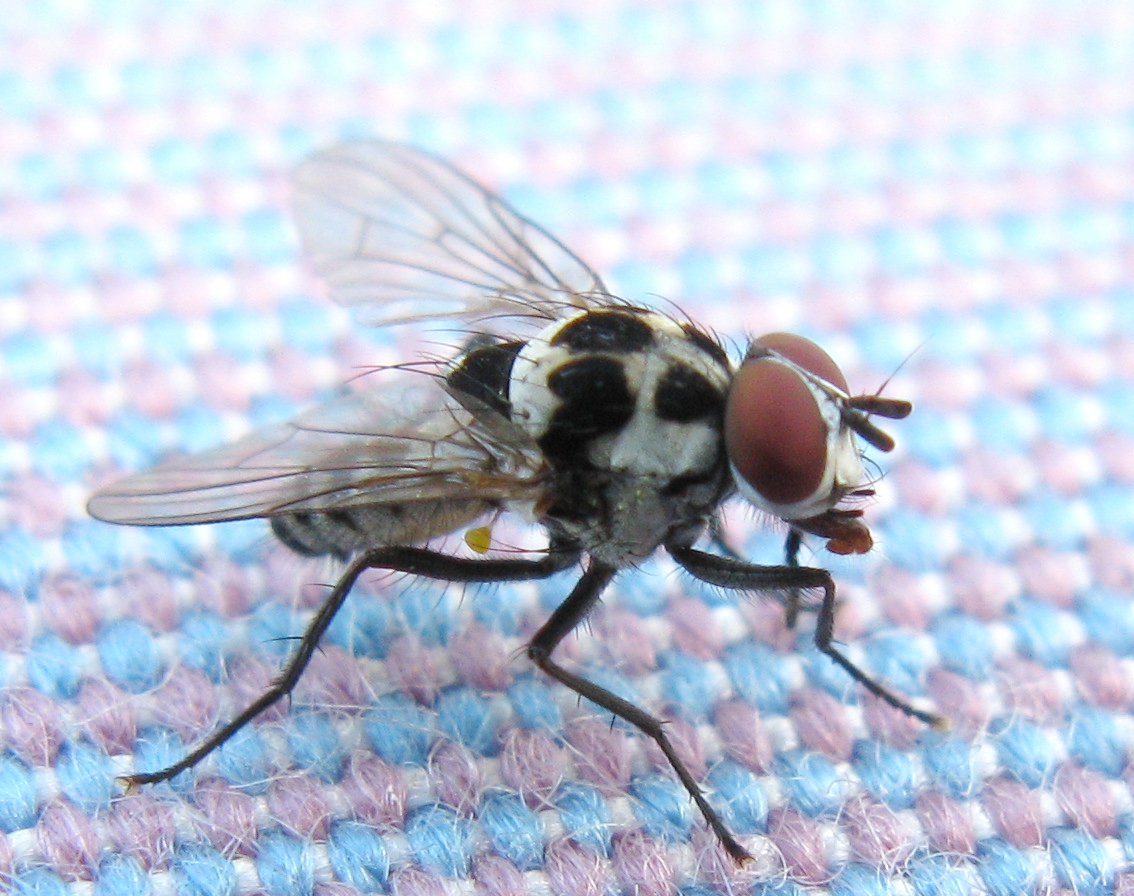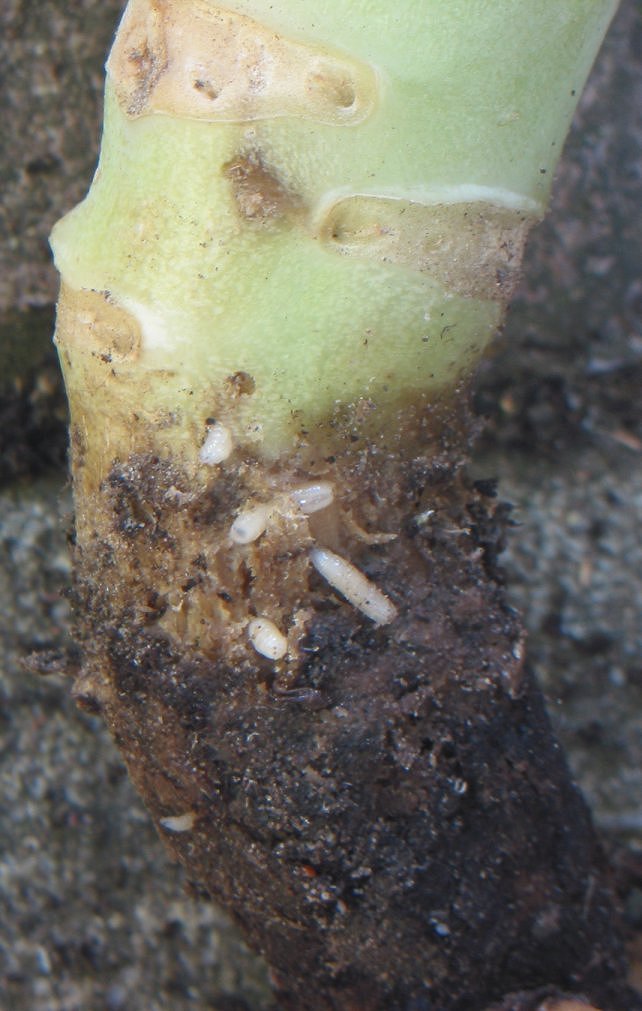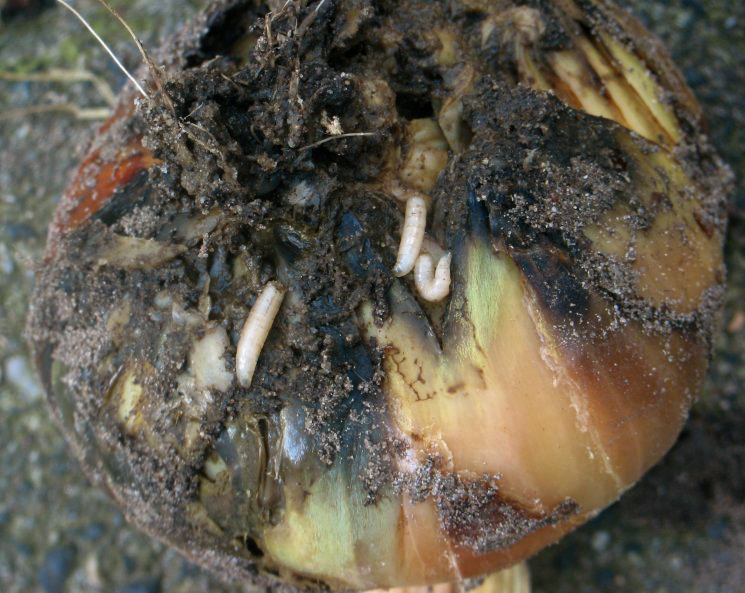|
Anthomyiidae
The Anthomyiidae are a large and diverse family of Muscoidea flies. Most look rather like small houseflies, but are commonly drab grey. The genus ''Anthomyia'', in contrast, is generally conspicuously patterned in black-and-white or black-and-silvery-grey. Most are difficult to identify, apart from a few groups such as the kelp flies that are conspicuous on beaches. The name Anthomyiidae was derived from Greek ''anthos'' (flower) plus ''myia'' (a fly). Some species are commonly called "root-maggots", as the larvae are found in the stems and roots of various plants. As larvae, some also feed on decaying plant material. The well-known grey "seaweed flies" or "kelp flies" ('' Fucellia'') are examples. Others are scavengers in such places as birds' nests; yet other species are leaf miners; the family also includes inquilines, commensals, and parasitic larvae. Some species in the family are significant agricultural pests, particularly some from the genus '' Delia'', which inclu ... [...More Info...] [...Related Items...] OR: [Wikipedia] [Google] [Baidu] |
Delia (genus)
''Delia'' flies are members of the Anthomyiidae family within the superfamily Muscoidae. The identification of different species of ''Delia'' can be very difficult for non-specialists as the diagnostic characteristics used for immature and/or female specimens may be inconsistent between species. Past taxonomic keys were not as comprehensive in their identification of ''Delia'' specimens; they were either too reliant on genetic characteristics, focused solely on a specific life stage, or were focused only on certain species. However current taxonomic keys aim to be more thorough by not only including morphological diagnostics for males, females, and immature specimens of various species, but also their genetic make-up or molecular barcode. Certain ''Delia'' species are of great economic importance as they are agricultural pests. The larvae of these flies, which tunnel into roots and stems of host plants, can cause considerable yield losses. Although most members of this genus have ... [...More Info...] [...Related Items...] OR: [Wikipedia] [Google] [Baidu] |
Anthomyiidae Sp
The Anthomyiidae are a large and diverse family of Muscoidea flies. Most look rather like small houseflies, but are commonly drab grey. The genus ''Anthomyia'', in contrast, is generally conspicuously patterned in black-and-white or black-and-silvery-grey. Most are difficult to identify, apart from a few groups such as the kelp flies that are conspicuous on beaches. The name Anthomyiidae was derived from Greek ''anthos'' (flower) plus ''myia'' (a fly). Some species are commonly called "root-maggots", as the larvae are found in the stems and roots of various plants. As larvae, some also feed on decaying plant material. The well-known grey "seaweed flies" or "kelp flies" ('' Fucellia'') are examples. Others are scavengers in such places as birds' nests; yet other species are leaf miners; the family also includes inquilines, commensals, and parasitic larvae. Some species in the family are significant agricultural pests, particularly some from the genus '' Delia'', which inclu ... [...More Info...] [...Related Items...] OR: [Wikipedia] [Google] [Baidu] |
Botanophila
''Botanophila'' is a genus of flies of the family Anthomyiidae. Species List of species according to Catalogue of Life The Catalogue of Life is an online database that provides an index of known species of animals, plants, fungi, and microorganisms. It was created in 2001 as a partnership between the global Species 2000 and the American Integrated Taxonomic I ...: References Muscoidea genera Anthomyiidae {{Muscoidea-stub ... [...More Info...] [...Related Items...] OR: [Wikipedia] [Google] [Baidu] |
Anthomyia
''Anthomyia'' is a genus of flies in the family Anthomyiidae. They look rather like small houseflies, but commonly have conspicuous black-and-white patterning. This appears to be a mild form of aposematic Aposematism is the advertising by an animal to potential predators that it is not worth attacking or eating. This unprofitability may consist of any defences which make the prey difficult to kill and eat, such as toxicity, venom, foul taste o ... coloration, though they do not appear to be distasteful unless they have eaten something offensive to the predator and have loaded their guts with it. Species References Anthomyiidae Articles containing video clips Schizophora genera Taxa named by Johann Wilhelm Meigen {{Muscoidea-stub ... [...More Info...] [...Related Items...] OR: [Wikipedia] [Google] [Baidu] |
Egle (fly)
''Egle'' is a genus of willow catkin flies in the family Anthomyiidae. There are at least 40 described species in ''Egle''. Species These 48 species belong to the genus ''Egle'': *'' E. acicularis'' Griffiths, 2003 *'' E. agilis'' ( Robineau-Desvoidy, 1830) *'' E. anderssoni'' Michelsen, 2009 *'' E. arctophila'' Griffiths, 2003 *'' E. asiatica'' Hennig, 1976 *'' E. atomaria'' ( Zetterstedt, 1845) *'' E. bicaudata'' ( Malloch, 1920) *'' E. brevicornis'' ( Zetterstedt, 1838) *'' E. ciliata'' (Walker, 1849) *'' E. claripennis'' ( Robineau-Desvoidy, 1830) *'' E. communis'' ( Robineau-Desvoidy, 1830) *'' E. concomitans'' ( Pandellé, 1900) *'' E. cyrtacra'' Fan & Wang, 1982 *'' E. exigua'' ( Robineau-Desvoidy, 1830) *'' E. falcata'' Ackland & Griffiths, 2003 *'' E. festiva'' ( Robineau-Desvoidy, 1830) *'' E. flavescens'' ( Robineau-Desvoidy, 1830) *'' E. floricola'' ( Robineau-Desvoidy, 1830) *'' E. florum'' ( Robineau-Desvoidy, 1830) *'' E. gracilior'' Zheng & Fan, 1990 *'' E. ignob ... [...More Info...] [...Related Items...] OR: [Wikipedia] [Google] [Baidu] |
Chirosia
''Chirosia'' is a genus of root-maggot flies in the family Anthomyiidae. There are over fifty described species in ''Chirosia''. Species These 58 species belong to the genus ''Chirosia'': *'' C. aberrans'' Collin, 1955 *'' C. abundepilosa'' ( Hennig, 1974) *'' C. aconiti'' (Ringdahl, 1948) *'' C. albifrons'' Tiensuu, 1938 *'' C. albitarsis'' ( Zetterstedt, 1845) *'' C. alpicola'' Villeneuve, 1923 *'' C. arnolitra'' (Huckett, 1924) *'' C. asperistilata'' Suwa, 1974 *'' C. asymmetrica'' Suwa, 2006 *'' C. beckeri'' Schnabl, 1911 *'' C. betuleti'' (Ringdahl, 1935) *'' C. bisinuata'' (Tiensuu, 1939) *'' C. cinerosa'' ( Zetterstedt, 1845) *'' C. consobrina'' (Huckett, 1929) *'' C. crassiseta'' Stein, 1908 *'' C. delicata'' (Huckett, 1949) *'' C. filicis'' (Huckett, 1949) *'' C. flavipennis'' ( Fallén, 1823) *'' C. forcipispatula'' Xue, 2001 *'' C. frontata'' Suwa, 1983 *'' C. gleniensis'' (Huckett, 1924) *'' C. grandivillosa'' (Huckett, 1924) *'' C. griseifrons'' ( Séguy, 1923) *' ... [...More Info...] [...Related Items...] OR: [Wikipedia] [Google] [Baidu] |
Hylemya
''Hylemya'' is a genus of root-maggot flies in the family Anthomyiidae. There are at least 30 described species in ''Hylemya''. Species These 31 species belong to the genus ''Hylemya'': *'' H. agrestis'' ( Robineau-Desvoidy, 1830) *'' H. alcathoe'' (Walker, 1849) *'' H. autumnalis'' ( Robineau-Desvoidy, 1830) *'' H. brevistyla'' Suwa, 2002 *'' H. bruneipalpis'' Fan, 1982 *'' H. detracta'' (Walker, 1853) *'' H. facilis'' ( Meigen, 1838) *'' H. femoralis'' (Stein, 1915) *'' H. flavicruralis'' Suwa, 1989 *'' H. flavipennis'' ( Robineau-Desvoidy, 1830) *'' H. genurfa'' ( Villeneuve, 1911) *'' H. kuntzei'' (Ringdahl, 1934) *'' H. latevittata'' (Stein, 1908) *'' H. longirostris'' Suwa, 1989 *'' H. meigeni'' (Schnabl, 1911) *'' H. neglecta'' (Karl, 1943) *'' H. nigrimana'' ( Meigen, 1826) *'' H. nigripes'' ( Robineau-Desvoidy, 1830) *'' H. partita'' ( Meigen, 1826) *'' H. probata'' (Walker, 1861) *'' H. probilis'' Ackland, 1967 *'' H. rufa'' ( Meigen, 1838) *'' H. seideli'' (Hering, 192 ... [...More Info...] [...Related Items...] OR: [Wikipedia] [Google] [Baidu] |
Hylemya Nigrimana
''Hylemya nigrimana'' is a species of fly in the family Anthomyiidae The Anthomyiidae are a large and diverse family of Muscoidea flies. Most look rather like small houseflies, but are commonly drab grey. The genus ''Anthomyia'', in contrast, is generally conspicuously patterned in black-and-white or black-and- .... It is found in the Palearctic . For identification see: Seguy, E. (1923) Diptères Anthomyides. Paris: Éditions ''Faune de France'' Faune n° 6 393 p., 813 fiBibliotheque Virtuelle Numerique pdf/ref> References External linksImages representing ''Hylemya nigrimana''at BOLD Anthomyiidae Insects described in 1826 Muscomorph flies of Europe {{Muscoidea-stub ... [...More Info...] [...Related Items...] OR: [Wikipedia] [Google] [Baidu] |
Delia Radicum
''Delia radicum'', known variously as the cabbage fly, cabbage root fly, root fly or turnip fly, is a pest of crops. The larvae of the cabbage root fly are sometimes known as the cabbage maggot or root maggot. The adult flies are about 1 cm long and are grey in colour, but otherwise resemble the common house fly. The flies can be found all over Europe. After overwintering as pupae in the soil, the flies emerge in spring, feed on nectar, and lay eggs close to plants of the genus ''Brassica''. The eggs are white and about 1 mm in diameter. They hatch into white maggots after about six days and the larvae feed for about three weeks on the roots and stems of the cabbage plants. After this, the larvae are typically 0.9 to 1 cm in length and form reddish-brown pupae which hatch into adult flies after around 20 days. This species is univoltine Voltinism is a term used in biology to indicate the number of broods or generations of an organism in a year. The term is most ... [...More Info...] [...Related Items...] OR: [Wikipedia] [Google] [Baidu] |
Delia Platura
''Delia platura'', the seedcorn maggot or the bean seed fly, is a fly species in the family Anthomyiidae. ''D. platura'' is an agricultural pest of peas and beans. It is a vector of bacteria that cause potato blackleg. It can be controlled by mouldboard ploughing A plough or plow ( US; both ) is a farm tool for loosening or turning the soil before sowing seed or planting. Ploughs were traditionally drawn by oxen and horses, but in modern farms are drawn by tractors. A plough may have a wooden, iron or .... See also * Agriculture in the United Kingdom References External links * * {{Taxonbar, from=Q13584748 Anthomyiidae Insects described in 1826 Agricultural pest insects Pulse crop diseases Diptera of Europe ... [...More Info...] [...Related Items...] OR: [Wikipedia] [Google] [Baidu] |
Delia Antiqua
''Delia antiqua'', commonly known as the onion fly, is a cosmopolitan pest of crops. The larvae or maggots feed on onions, garlic, and other bulbous plants. Morphology and biology The onion fly has an ash-grey body and resembles a housefly. The male has a longitudinal stripe on the abdomen which is lacking in the female. The legs are black, the wings transparent, and the compound eyes brown. The eggs are white and elongated and are laid in groups on the shoots, leaves, and bulbs of host plants and on the ground nearby. The larvae are white and cylindrical and hatch in 3 to 8 days. Each batch of larvae tends to keep together and collectively create large cavities in bulbs. More than 50 maggots may feed on one bulb, sometimes originating from eggs laid by several females. The larvae moult three times, feed for about 20 days, and grow to about 1.0 cm long. The pupa is brown, ringed, and ovoid and measures long. Pupation occurs in the ground with the pupal phase from the ... [...More Info...] [...Related Items...] OR: [Wikipedia] [Google] [Baidu] |
Fucellia
''Fucellia'' is a genus of seaweed flies in the family Anthomyiidae. There are at least 20 described species in ''Fucellia''. Species These 28 species belong to the genus ''Fucellia'': *'' F. aestuum'' Aldrich, 1918 *'' F. albeola'' Huckett, 1927 *'' F. antennata'' Stein, 1910 *'' F. apicalis'' Kertész, 1908 *'' F. ariciiformis'' ( Holmgren, 1872) *'' F. assimilis'' Malloch, 1918 *'' F. biseriata'' Huckett, 1966 *'' F. boninensis'' Snyder, 1965 *'' F. calcoerata'' ( Macquart, 1851) *'' F. capensis'' ( Schiner, 1868) *'' F. chinensis'' Kertész, 1908 *'' F. costalis'' Stein, 1910 *'' F. fucorum'' ( Fallén, 1819) *'' F. griseola'' ( Fallén, 1819) *'' F. hypopygialis'' Ringdahl, 1930 *'' F. intermedia'' ( Zetterstedt, 1845) *'' F. kamtchatica'' Ringdahl, 1930 *'' Fucellia maritima'' (Haliday, 1838) *'' F. pictipennis'' Becker, 1907 *'' F. pluralis'' Huckett, 1965 *'' F. rejecta'' Aldrich, 1918 *'' F. rufitibia'' Stein, 1910 *'' F. separata'' Stein, 1910 *'' F. signata'' ( Z ... [...More Info...] [...Related Items...] OR: [Wikipedia] [Google] [Baidu] |





.jpg)


